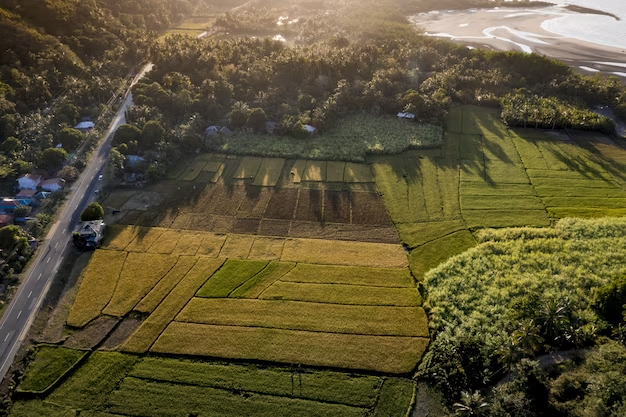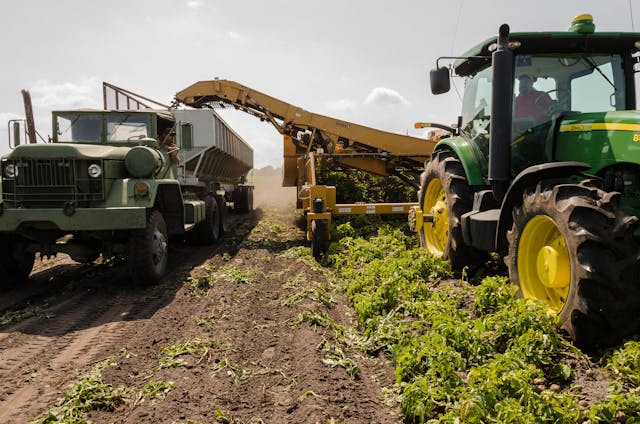The allure of wide expanses and unspoiled natural landscapes in agricultural land often draws those who envision constructing their own living space. The critical inquiry, however, is whether building upon such zones designated for agriculture is permissible. This article delves into the particulars concerning what edifices may be erected on agrarian properties, with a particular emphasis on potential opportunities and constraints related to creating dwellings within these regions.
Understanding Agricultural Zoning

To properly address the question of whether building a house on agricultural land is possible, it’s essential to first grasp the concept of agricultural zoning. The primary objective behind such classification is preserving and safeguarding farmland by regulating its usage to primarily support agriculture-related operations while restricting construction options available.
What Can Be Built on Agricultural Land?
Commonly, the edifices allowed to be erected on agricultural zoned property are those that facilitate farming and livestock endeavors. These comprise:
| Structures | Function | Sizes | Zoning Considerations |
| Barns and Livestock Shelters | To provide a safe haven from inclement weather and possible predators, it is necessary to have barns or shelters for accommodating farm animals like cows, horses, chickens as well as goats. These facilities are vital in ensuring the adequate housing and protection of livestock on farms. | The capacity of a barn or shelter for animals may differ considerably, based on the number and size of creatures it is meant to contain. Smaller edifices might suffice for limited livestock populations, while bigger structures are intended to host complete groups. | Zoning regulations may specify setbacks from property lines and neighboring structures to ensure safety and proper land use. Some jurisdictions may also have restrictions on the height and appearance of barns. |
| Storage Sheds for Farming Equipment | The purpose of storage sheds is to provide a secure location for agricultural equipment, machinery and tools. These structures serve as protection against theft and harsh weather conditions, safeguarding valuable assets. | The storage shed’s dimensions are contingent on the farm’s requirements. Compact sheds can house hand tools and less substantial equipment, whereas more expansive variants have room for tractors and other bulky machinery. | Local zoning codes may have guidelines regarding the size, location, and appearance of storage sheds. Compliance with these regulations is essential to avoid potential legal issues. |
| Greenhouses | By offering a regulated climate for the growth of plants and crops, greenhouses facilitate cultivation by enabling extended growing periods, shielding against harsh weather conditions while also permitting farmers to produce distinct varieties. | The dimensions of greenhouses vary, ranging from modest backyard installations to extensive commercial enterprises. The sizing is determined by the extent and nature of agricultural pursuits pertaining to different crops. | Zoning regulations may have specific requirements for the construction and operation of greenhouses, including setbacks, height restrictions, and environmental considerations. |
| Farm Produce Stands | Farmers can sell their fresh produce directly to consumers at farm produce stands, which are structures that play a vital role in supporting local agriculture and offering people access to locally grown, nutritious food. | Farm produce stands come in a range of sizes, from modest roadside stalls to larger establishments featuring seating areas and refrigeration. | Local zoning laws often dictate where and how farm produce stands can operate. They may address issues such as signage, parking, and hours of operation. |
Can You Build a House on Agricultural Land?
Building a house on agricultural zoned land is often subject to stringent rules. While it’s not entirely off the table, there are several factors to consider:
Local Zoning Laws
Local zoning laws play a pivotal role in determining whether you can build a house on agricultural land. These laws, established by local governments or municipalities, define the permissible land uses in specific zones, including agricultural zones. The zoning laws are the final word on what can and cannot be built on the land. It is crucial to thoroughly research and understand the zoning regulations in your area before proceeding with any construction plans. Below are the factors to consider regarding local zoning laws:
- Land Use Classification: Agricultural zoning typically restricts land use to farming, ranching, and related activities. Residential use may not be permitted in these zones, or it may be subject to strict conditions.
- Agricultural Operations: Some regions may allow residential construction on agricultural land if it does not impede agricultural operations. This means that you may need to demonstrate that your proposed house will not interfere with farming activities, such as irrigation, planting, or harvesting.
- Special Use Permits: In certain cases, you may be able to obtain a special use permit or variance from local authorities to build a house on agricultural land. These permits are often granted when you can prove that your project will not harm the agricultural character of the area.
Size and Scale Restrictions
Even if local zoning laws permit residential construction on agricultural land, there are likely to be limitations on the size and scale of the house you can build. These restrictions are typically put in place to ensure that the primary focus of the land remains agricultural. Here are some factors to consider regarding size and scale restrictions:
- Maximum Building Footprint: Zoning regulations may specify the maximum allowable building footprint, which is the area of land covered by the house and any associated structures. This limitation is intended to prevent large, sprawling residences on agricultural land.
- Building Height: Height restrictions may also apply, limiting the number of stories or the overall height of the house. This is done to maintain the rural and open character of the area.
- Setback Requirements: Setback requirements dictate how far the house must be situated from property lines, roads, and other structures. These setbacks help preserve the agricultural landscape and ensure safety.
Agricultural Ties
In some areas, you may need to establish and prove your genuine involvement in farming or agricultural activities to obtain permission to build a house on agricultural land. These requirements are designed to ensure that individuals seeking to build on agricultural land are genuinely committed to preserving the agricultural character of the area. Here are some considerations regarding agricultural ties:
- Farming Experience: You may be required to demonstrate your farming experience or knowledge to show that you are capable of actively participating in agricultural activities on the land.
- Business Plan: Some regions may ask for a comprehensive business plan outlining your agricultural goals, such as crop cultivation, livestock farming, or other relevant activities.
- Environmental Impact Assessment: Local authorities might request an environmental impact assessment to evaluate the potential effects of your residential construction on the surrounding agricultural ecosystem.
- Periodic Inspections: In certain cases, ongoing inspections may be conducted to ensure that you are actively engaged in agricultural practices as promised in your application.
Navigating the Approval Process

Getting approval to build a house on agricultural land can be a complex process. Here are some steps typically involved:
Pre-application Consultation
Before diving into the formal application process, it is advisable to initiate a pre-application consultation with local authorities. This crucial step allows you to engage with regulatory bodies, such as zoning boards or planning commissions, to discuss your plans and gain valuable insights into the specific requirements and constraints of building on agricultural land. Key considerations during this phase include:
- Zoning Regulations: Gain a deep understanding of local zoning regulations related to agricultural land. Discuss with authorities how these regulations may apply to your project.
- Permissible Land Use: Inquire about the types of land use allowed in the agricultural zone and the potential for residential development. It is essential to understand the local stance on balancing residential and agricultural interests.
- Environmental Concerns: Seek information about any environmental concerns related to your proposed construction. This early dialogue can help you address potential issues proactively.
- Application Requirements: Clarify the documentation and information required for a formal application. This will help you prepare a comprehensive submission.
Formal Application Submission
Once you have gathered insights during the pre-application consultation, the next step is to prepare and submit a formal application to the relevant authorities. This application serves as the official request for permission to build a house on agricultural land. Key components of a formal application may include:
- Detailed Plans: Provide detailed architectural plans and site layouts that clearly illustrate the house’s design, size, and placement on the land. These plans should adhere to local zoning regulations.
- Justifications: Include a well-structured justification for why the construction of a house on agricultural land is necessary and how it supports agricultural activities. This might involve demonstrating a genuine commitment to farming or ranching.
- Property Survey: Submit a property survey showing property boundaries, setbacks, and any existing structures. Compliance with setback requirements is crucial.
- Compliance with Size and Scale Restrictions: Ensure that the proposed house conforms to any size and scale restrictions imposed by local zoning laws. This may include limitations on building footprint and height.
- Financial Considerations: Be prepared to provide information regarding financing for the construction project. Local authorities may want assurance that the project is financially viable and sustainable.
Impact Assessments
In many cases, the approval process for building a house on agricultural land necessitates comprehensive impact assessments. These assessments are designed to evaluate the potential effects of the construction on the environment, agricultural operations, and the surrounding community. Important aspects of impact assessments include:
- Environmental Impact Assessment: This assessment involves studying how the construction and occupancy of the house may affect the local environment, including soil quality, water sources, and wildlife habitats. Mitigation measures may be required to minimize negative impacts.
- Agricultural Impact Assessment: Demonstrate that the presence of the house will not hinder or disrupt agricultural activities on the land. This may involve providing plans for farm management and addressing concerns related to noise, traffic, and chemical use.
- Community Impact Assessment: Assess how the new residential development will impact the local community in terms of infrastructure, services, and land values. Engage with the community to address any concerns or objections.
Factors to Consider When Building on Agricultural Land
To ensure a successful and sustainable project, it is crucial to take into account several key factors. Let’s explore the critical considerations when building on agricultural land, emphasizing environmental impact, infrastructure accessibility, and future land use preservation.
Environmental Impact
Agricultural land is often characterized by its environmental sensitivity, making it essential to assess and mitigate any potential adverse impacts resulting from construction. The following aspects should be carefully considered:
- Soil Quality: Agricultural activities rely heavily on the quality of the soil. Construction can lead to soil compaction, contamination, or erosion. Measures such as soil testing and erosion control plans should be integrated into the project to maintain soil health.
- Wildlife Habitats: Agricultural lands may host diverse wildlife habitats. Building can disrupt these ecosystems, potentially affecting local wildlife populations. Conducting a wildlife impact assessment can help identify critical habitats and implement protective measures.
- Ecosystem Balance: Recognize the interconnectedness of the broader ecosystem. Changes to water flow, vegetation, or land use can have cascading effects. Sustainable construction practices and habitat restoration can help maintain ecological balance.
Infrastructure Accessibility
Access to basic infrastructure can vary significantly on remote agricultural lands. The absence of essential services like roads, electricity, and water supply can pose substantial challenges. Key considerations in this regard include:
- Road Connectivity: Evaluate the feasibility and cost of creating road access to the building site. Access roads are vital for construction and future maintenance.
- Utility Provision: Determine the availability of electricity and water supply. If these utilities are not readily accessible, assess the feasibility of extending utility lines to the property and include the associated costs in your budget.
- Waste Disposal: Plan for waste disposal solutions, including sewage systems and trash removal, particularly in areas where municipal services may be limited.
Future Land Use Preservation
One of the primary goals when building on agricultural land is to ensure that the construction does not compromise the land’s future agricultural productivity. Consider the following strategies to preserve the land’s agricultural potential:
- Site Placement: Carefully select the location for your building to minimize disruption to farming activities. Maintain adequate setbacks from farming areas to avoid interference.
- Agricultural Compatibility: Design the building and landscaping with agriculture in mind. This includes considering the impact of shading, water runoff, and any potential use of chemicals on adjacent crops or livestock.
- Farm Management Plan: Develop a comprehensive farm management plan that outlines how the building will coexist with agricultural operations. Address issues such as access routes, storage, and noise management.
- Sustainable Practices: Implement sustainable construction practices and materials to minimize the environmental footprint of the building and its ongoing maintenance.
Conclusion
While you can build on agricultural zoned land, it’s a path laden with regulations and considerations. The dream of building a house amidst the serenity of farmland can be a reality, but it requires thorough planning and adherence to local laws. This endeavor not only reflects a personal dream but also a commitment to preserving the agricultural heritage of the land.
Remember, each case is unique, and it’s crucial to consult with local authorities to understand the specific regulations and processes in your area. With the right approach, your vision of a home on agricultural land can beautifully coexist with the land’s primary purpose of agriculture.
FAQ
Q1: Can you build any type of house on agricultural land?
A: The style and size of the house are often regulated. It typically needs to be functional and in harmony with the agricultural setting.
Q2: Are there tax implications when building a house on agricultural land?
A: Yes, changing the land use can affect property taxes. It’s essential to check with local tax authorities.
Q3: Can I subdivide agricultural land for residential development?
A: This is usually highly restricted. Agricultural zoned land is meant to be preserved for farming purposes.
Q4: Can agricultural land be rezoned for residential use?
A: Rezoning is possible but typically challenging and subject to strict criteria and public hearings.
Q5: What happens if I build without proper permits?
A: Building without permits can lead to legal issues, including fines and the potential demolition of the structure.







